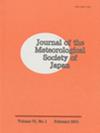A Feasibility Study on the High-Resolution Regional Reanalysis over Japan Assimilating Only Conventional Observations as an Alternative to the Dynamical Downscaling
IF 1.6
4区 地球科学
Q3 METEOROLOGY & ATMOSPHERIC SCIENCES
引用次数: 8
Abstract
The feasibility of regional reanalysis assimilating only conventional observations was investigated as an alternative to dynamical downscaling to estimate the past three-dimensional high-resolution atmospheric fields with long-term homogeneity over about 60 years. The two types of widely applied dynamical downscaling approaches have problems. One, with a serial long-term time-integration, often fails to reproduce synoptic-scale systems and precipitation patterns. The other, with frequent reinitializations, underestimates precipitation due to insufficient spin-up. To address these problems maintaining long-term homogeneity, we proposed the regional reanalysis assimilating only the conventional observations. We examined it by paying special attention to summer precipitation, through one-month experiment before conducting a long-term reanalysis. The system was designed to assimilate surface pressure and radiosonde upper-air observations using the Japan Meteorological Agency’s nonhydrostatic model (NHM) and the local ensemble transform Kalman filter (LETKF). It covered Japan and its surrounding area with a 5-km grid spacing and East Asia with a 25-km grid spacing, applying one-way double nesting in the Japanese 55-year reanalysis (JRA-55). The regional reanalysis overcame the problems with both types of dynamical downscaling approaches. It reproduced actual synoptic-scale systems and precipitation patterns better. It also realistically described spatial variability and precipitation intensity. The 5-km grid spacing regional reanalysis reproduced frequency of heavy precipiJournal of the Meteorological Society of Japan Vol. 96, No. 6 566日本高分辨率区域再分析的可行性研究——仅同化常规观测作为动力降尺度的替代方案
研究了仅同化常规观测资料的区域再分析作为动态降尺度的替代方法,用于估计60多年来具有长期均匀性的过去三维高分辨率大气场的可行性。两种广泛应用的动态降尺度方法都存在问题。一种是用连续的长期时间积分,往往不能再现天气尺度系统和降水模式。另一种,由于频繁的重新初始化,由于自旋上升不足而低估了降水。为了解决这些问题,我们提出了仅吸收常规观测值的区域再分析。在进行长期再分析之前,我们特别关注夏季降水,通过一个月的实验进行了检验。该系统采用日本气象厅的非流体静力模式(NHM)和局地集合变换卡尔曼滤波(LETKF)来同化地表压力和无线电探空仪的高空观测。日本55年再分析(JRA-55)采用单向双嵌套,网格间距为5 km,网格间距为25 km,覆盖日本及其周边地区。区域再分析克服了两种动态降尺度方法存在的问题。它较好地再现了实际天气尺度系统和降水模式。它也真实地描述了空间变异性和降水强度。5 km格距区域再分析再现强降水频率[j] .日本气象学会学报,96卷,第6 566期
本文章由计算机程序翻译,如有差异,请以英文原文为准。
求助全文
约1分钟内获得全文
求助全文
来源期刊
CiteScore
6.70
自引率
16.10%
发文量
56
审稿时长
3 months
期刊介绍:
JMSJ publishes Articles and Notes and Correspondence that report novel scientific discoveries or technical developments that advance understanding in meteorology and related sciences. The journal’s broad scope includes meteorological observations, modeling, data assimilation, analyses, global and regional climate research, satellite remote sensing, chemistry and transport, and dynamic meteorology including geophysical fluid dynamics. In particular, JMSJ welcomes papers related to Asian monsoons, climate and mesoscale models, and numerical weather forecasts. Insightful and well-structured original Review Articles that describe the advances and challenges in meteorology and related sciences are also welcome.

 求助内容:
求助内容: 应助结果提醒方式:
应助结果提醒方式:


